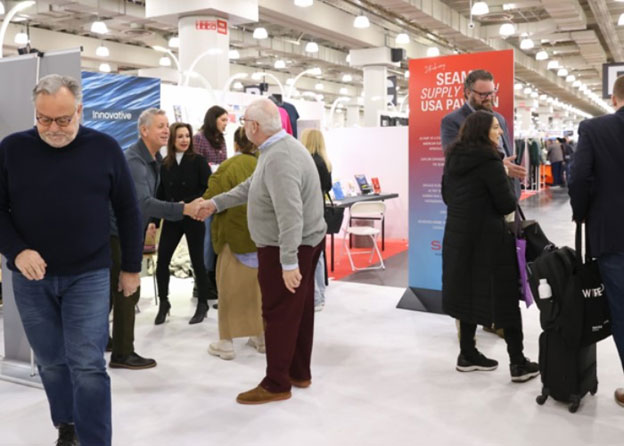February 13, 2024

The Key to Boosting Sales in 2024: Value
Nailing down what shoppers want has never been easy. And as retail still fights to recover from the rollercoaster of the pandemic years, it can be harder than ever to identify a new normal when it comes to consumer preferences. As tastes and habits continue to shift, the need to decode demand is higher than ever. Fitch Ratings projects spending to slow in 2024. Mastercard anticipates the tug of war for share of wallet between purchases and experiences will continue. Going forward, apparel sales will hinge on delivering product consumers truly feel is worth their dollars.
“In spite of consumer spending continuing to be up, they're being much more selective in terms of where they're spending their money.” Nora Kleinewillinghoefer, partner in the consumer and retail practice at management consulting firm Kearney, told Texworld. “What we're seeing across the board is that the consumer base is diversifying and continuing to be less conformist. Many brands have started to cater to that, whether it's size inclusivity, gender neutrality—all the different elements that create a very diverse society.”
While this new consumer sounds challenging to peg, some things remain consistent. Sunny Zheng, research analyst for data and advisory firm Coresight Research, said price is still king. “While consumers may still splurge on occasional luxury items or investment pieces, they are increasingly mindful of value for money and seek discounts, promotions, and value-added incentives,” Zheng told Texworld.
The good news is, value doesn’t only equal price, according to Jason Kra, PhD, president, Li & Fung Ltd. “Value is everything—multiple use, last longer—so we have to look at products that can be more universal, and we're seeing that work at retail,” Kra stated in Texworld’s 2024 outlook whitepaper.
But the focus on value is driven by the economy.
“In the face of rising price consciousness amongst consumers compounded with ongoing economic pressures across the globe, consumers are more often resonating with value-minded products and styles that can stand the test of time,” said Nia Silva, director of materials for consumer insight company Fashion Snoops told Texworld. “Think structured and durable denims, woolen fiber blends and classic neutral color palettes that truly feel worth the investment as timeless staples.”
The one caveat, she said, is Gen Z, which has a strong propensity for fast fashion. Millennials and Gen X, on the other hand, want products that will last. These value attributes dovetail with so-called quiet luxury, she said. In an environment in which consumers are constantly presented with a barrage of new trends, these pieces are a safer investment for both shoppers and retailers.
“Consumers are seeking out products, like a classic gabardine trench, cashmere knit sweater, or full grain leather tote that all meet higher standards in quality and value. These are trans-seasonal pieces that can work as the building blocks of a consumer's existing wardrobe,” she said. “And it’s also important to note that oftentimes material quality is super key with these pieces, fabric weights are typically heavier, handfeel more supple and soft, and constructions more forgiving for repeated wear.”
Kearney’s Kleinewillinghoefer said brands have been bolstering their credibility in this area through collaborations or long-term partnerships. “Whether it's Gore-tex or Vibram soles, they’re anchoring on something that's recognizable for the consumer that they can relate to,” she said.
Further, sustainability often goes hand in hand with conversations around quality and durability. For instance, Kleinewillinghoefer said consumers gravitate toward products that are recyclable and have an affinity for the mechanisms that allow for re-commerce.
“Today's apparel shoppers prioritize products that offer durability, newness, versatility, and reflect their personal style and values,” Zheng said. “Attributes such as sustainability, ethical sourcing, and transparent production processes resonate strongly with consumers, driving their willingness to spend more on eco-friendly materials, ethically made garments, and timeless designs.”
It’s a values-centered consumerism that resonates most with younger shoppers, Zheng said. For older demographics, craftsmanship, exclusivity and luxury are key.
Either way, delivering on value is a safer bet for brands and retailers that don’t have the ability to keep up with the latest fad. “Especially with the speed and fickleness of digital trend cycles, retailers should shift their gaze to items that evoke a higher quality or even multifunctionality, where possible,” Silva said.

Texworld Focuses on Domestic Sourcing Solutions at Winter 2024 Edition
Texworld has expanded its local sourcing area through a new partnership with the foremost association and voice of the U.S. sewn products industry for over 50 years. The SEAMS Supply Chain USA Pavilion is designed to answer the increasing need for domestic products and resources.
“SEAMS is focused on domestic manufacturing and resources, building our industry’s strength through knowledge and experienced resources, and this partnership is a perfect unified front for the industry we serve,” states Ron Roach, SEAMS President.
The SEAMS Supply Chain USA Pavilion provides U.S.-based resources as well as new educational opportunities related to the U.S. textile industry, the resurgence in interest in Made in America, and how the association supports the 200+ fashion brands, retailers, manufacturers, and textile providers in its membership.
If you missed the SEAMS Textile Talk, click here to watch now.

Texworld Los Angeles and Apparel Sourcing Los Angeles Return
Mark your calendars! Texworld Los Angeles and Apparel Sourcing Los Angeles will take place August 13-14, 2024, at the California Market Center (CMC). This summer’s event will capitalize on the success of the 2023 debut, featuring an extensive range of fashion textiles, apparel, accessories, local sourcing resources, and more from countries including Korea, Peru, China, USA, India and Türkiye.
In addition to the unparalleled buying opportunities, the show will also feature engaging seminars and panel discussions led by top industry experts, as well as an inspiring F/W 24/25 trend display, curated by NYC-based agency, Doneger | TOBE. Texworld Los Angeles and Apparel Sourcing Los Angeles will once again welcome show partners Printsource, Lenzing Fibers and CCPIT-TEX, and it will spotlight sustainability through Messe Frankfurt’s “Texpertise Econogy” initiative.
Don’t miss out. Register for the show today here.

What We’re Reading
How Tapestry is Scaling Circularity Among its Luxury Brands
“Sustainability is a business imperative,” says Tapestry’s CEO. To that end, the company is focusing on areas like material innovation, circularity and waste reduction. Sustainability Magazine reports on the fashion conglomerate’s Tapestry of Change report, which enumerates its 2025 and 2027 goals for traceability, recycled content and regenerative agriculture. Learn about how the company is leveraging partnerships with TrusTrace, the Ellen MacArthur Foundation and Generation Phoenix to further bolster its sustainability-related achievements.
T.J. Maxx and thrift stores are siphoning shoppers from full-price rivals
Consumers may be shopping but often full-price stores are losing out. That’s the message from a Quartz article that found that only two in five shoppers opt for full price, according to research firm Placer.ai. That’s a decrease from five years ago when half of consumers shopped there. In 2017, full-price share of foot traffic was 50 percent; in 2023 it was just under 39 percent. The reason: both thrift and off-price offer the thrill of the hunt, plus everyone loves a bargain. Read the article to learn more about consumer shopping habits today.
Red Sea disruptions may drive port congestion, inflation
Attacks on commercial shipping along the Red Sea could spell congestion and higher inflation, if the situation persists, according to Supply Chain Dive. Longer transit times have already caused delays and increased shipping rates are weighing on margins. The NRF says the issues are having a domino effect, causing bottlenecks on rail lines as shipments are rerouted to West Coast ports. Find out how the retail industry is trying to avoid revisiting the freight issues brought on by the pandemic.